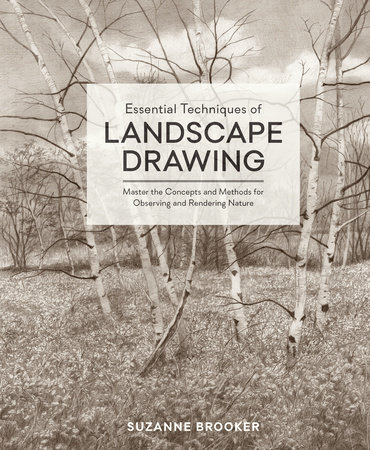Excerpt
Essential Techniques of Landscape Drawing
Chapter 1: The Basics of Landscape Drawing
WHAT IS VISUAL THINKING?
Visual thinking is a different, non-verbal mode of thinking as compared to those used for analyzing, reasoning or communicating with language. It is based on a visual language of line, shape, color, value, and texture—the formal elements that create all visual images. You can think of visual thinking as if it were a new alphabet, one made up of pencil marks that when assembled make up grass, clouds, and water, instead of words, sentences, and thoughts. Essentially, all drawings are made up of abstract marks organized via visual thinking to convey a sense of representation or realness for the viewer. After all, paper is flat but the world is filled with dimension. As a result, you can think of a drawn image as the art of illusion, of creating the resemblance of volume and space.
Developing our observational skills becomes important since what we draw is our
perceptions of the natural world. The process of drawing opens your perceptions of the visible world through an active process of observation where
what your eyes see-by-looking is melded to the mental function of
noticing. Learning to draw is not only about seeing in a new way, but also translating what you see through drawing techniques and the visual traditions of Western culture. In the following chapters, you’ll learn more about specific techniques and how these skills are applied in landscape drawing.
The importance of drawing can never be overstated. Through drawing, you activate a connection between your eyes and your brain through to your hand that reflects your thoughts and perceptions revealed through drawing materials. In other words, visual thinking is the way you perceive the world around you and convert those observations via the drawing process.
Drawing as a finished product doesn’t even matter as much as the process of drawing itself does. One of the benefits of learning to draw is that it enhances your mental functions, literally building new connections within your brain. Although we consider communicating with language as the most important brain function, it is vision that dominates our senses. Drawing utilizes the right side of your brain, which perceives spatial relationships, patterns and shape relationships. Unlike the left side of your brain, it has no words/language as it perceives the world visually. For instance, without the right side of your brain you wouldn’t be able to drive or walk down a simple stairway! The left side of your brain however, is verbal and functions visually by symbol recognition. It gives verbal labels for what you see (grass, dog, tree) and stops noticing once an object is identified. A drawing practice focuses your mental attention on the present moment and quiets the verbal chatter of your left brain so you can see/notice what the right brain is observing. This opens your awareness of the natural world away from the concerns of daily life.
***




